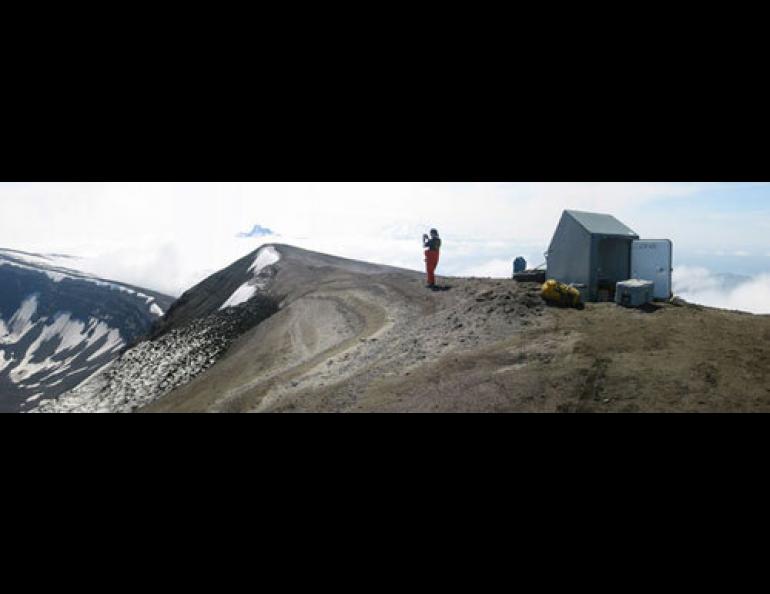
A bad night in a good box
This column first appeared in 2003.
On a wet, windy, foggy night a few summers ago, Guy Tytgat checked into the loneliest hotel in the Aleutians. His room was four feet wide and five feet tall, made of fiberglass, and perched on the lip of a volcanic crater.
Tytgat did not enjoy the long night he shared with 420 pounds of batteries, an antenna and seismic equipment, but he is thankful the little gray hut was there.
Tytgat, now working at New Mexico Tech, was in 2003 a geophysicist with the Alaska Volcano Observatory. For more than 20 years, he had installed and repaired seismic stations across Alaska, from 14,000 feet high on Mount Wrangell to Umnak Island in the Aleutians. He was on Umnak Island a few years ago (before Okmok’s 2008 eruption) when he spent the night in an equipment hut.
The huts contain seismometers that allow scientists at AVO to monitor the rumbles of distant volcanoes from their offices in Anchorage and Fairbanks. Also enclosed in the huts are computers, antennas, batteries, and radios to transmit earth-motion data to relay stations.
Tytgat was on Umnak Island to finish up a seismic network on the flanks of Okmok Volcano. While working on a station lower on the island, he noticed that the rim of Okmok crater was visible, with blue sky in the background. A hut on the rim needed solar panels installed, so Tytgat grabbed them and jumped in a helicopter.
The helicopter pilot dropped him near the hut on the crater rim. Tytgat pulled out the solar panels, his toolbox, and a waterproof bag full of survival gear. The pilot then took off and found a less precarious place to park the helicopter.
A dense fog crept in while Tytgat worked on the solar panels. When he finished, he called over his radio to the helicopter pilot, who gave Tytgat his GPS coordinates and told him to hike over to the helicopter. Before Tytgat could reach the helicopter, the pilot took advantage of a gap in the fog to descend from the slope.
By that time, about three hours after he installed the solar panels, Tytgat was wet, cold, and not sure he could reach the helicopter by dark. He then made the difficult decision to retreat to the hut for the night.
His GPS guided him back to the hut, which was streaked with rain and vibrating in the wind. He creaked open the door, stepped in, pulled his dry-bag inside, and slammed it shut.
Once inside the dark chamber, Tytgat pulled fresh clothes and a sleeping bag from the dry-bag of survival gear he never leaves a helicopter without. He wriggled into the warm clothes and the minus 20 degrees Fahrenheit sleeping bag, and then tried to get comfortable on a narrow bench.
The hut was watertight, but condensation dripped from the ceiling. Adding to his anxiety were memories of two huts that he had just visited—lighting had struck and destroyed one, and the wind had ripped another from its cement footings and blew it over a cliff. As his mind raced through scenarios, gusts of wind rattled the tiny hut.
“I was pretty nervous,” he said. “Either I could get hit by lightning or blown off the mountain.”
After a retched night, Tytgat crawled from the hut in the morning to see nothing but fog. Knowing he needed to make the most of his daylight, he leaned into the wind and started hiking along the rim of the volcano, staying on top so he wouldn’t get lost. Through a marginal hole in the fog, the helicopter pilot landed and retrieved him. Tytgat spent much of the day warming himself by a woodstove at a ranch belonging to a family living on the island.
Looking back on his night in that box atop Okmok, Tytgat said it confirmed a few points—scientific fieldwork in Alaska is often more of a challenge than it seems, and a field hand’s best friend is his survival bag.
“I wouldn’t go out without it,” he said.
2009 post-script: The hut survived Okmok’s dramatic eruption in July 2008, though a similar hut was “nearly at ground zero” and was destroyed, according to the Geophysical Institute’s Jessica Larsen.





